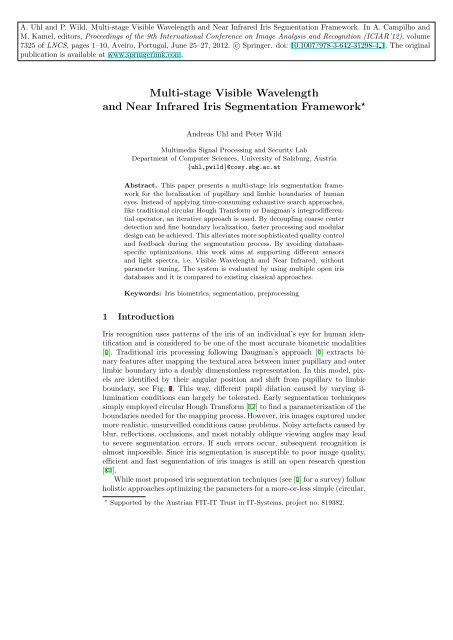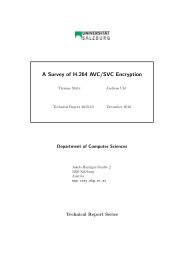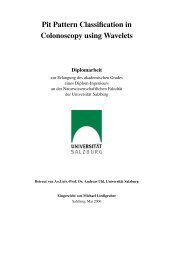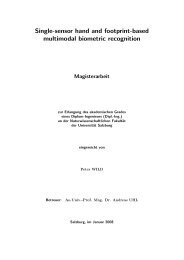Multi-stage Visible Wavelength and Near Infrared Iris ... - WaveLab
Multi-stage Visible Wavelength and Near Infrared Iris ... - WaveLab
Multi-stage Visible Wavelength and Near Infrared Iris ... - WaveLab
Create successful ePaper yourself
Turn your PDF publications into a flip-book with our unique Google optimized e-Paper software.
A. Uhl <strong>and</strong> P. Wild. <strong>Multi</strong>-<strong>stage</strong> <strong>Visible</strong> <strong>Wavelength</strong> <strong>and</strong> <strong>Near</strong> <strong>Infrared</strong> <strong>Iris</strong> Segmentation Framework. In A. Campilho <strong>and</strong>M. Kamel, editors, Proceedings of the 9th International Conference on Image Analysis <strong>and</strong> Recognition (ICIAR’12), volume7325 of LNCS, pages 1–10, Aveiro, Portugal, June 25–27, 2012. c⃝ Springer. doi: 10.1007/978-3-642-31298-4 1. The originalpublication is available at www.springerlink.com.<strong>Multi</strong>-<strong>stage</strong> <strong>Visible</strong> <strong>Wavelength</strong><strong>and</strong> <strong>Near</strong> <strong>Infrared</strong> <strong>Iris</strong> Segmentation Framework ⋆Andreas Uhl <strong>and</strong> Peter Wild<strong>Multi</strong>media Signal Processing <strong>and</strong> Security LabDepartment of Computer Sciences, University of Salzburg, Austria{uhl,pwild}@cosy.sbg.ac.atAbstract. This paper presents a multi-<strong>stage</strong> iris segmentation frameworkfor the localization of pupillary <strong>and</strong> limbic boundaries of humaneyes. Instead of applying time-consuming exhaustive search approaches,like traditional circular Hough Transform or Daugman’s integrodifferentialoperator, an iterative approach is used. By decoupling coarse centerdetection <strong>and</strong> fine boundary localization, faster processing <strong>and</strong> modulardesign can be achieved. This alleviates more sophisticated quality control<strong>and</strong> feedback during the segmentation process. By avoiding databasespecificoptimizations, this work aims at supporting different sensors<strong>and</strong> light spectra, i.e. <strong>Visible</strong> <strong>Wavelength</strong> <strong>and</strong> <strong>Near</strong> <strong>Infrared</strong>, withoutparameter tuning. The system is evaluated by using multiple open irisdatabases <strong>and</strong> it is compared to existing classical approaches.Keywords: <strong>Iris</strong> biometrics, segmentation, preprocessing1 Introduction<strong>Iris</strong> recognition uses patterns of the iris of an individual’s eye for human identification<strong>and</strong> is considered to be one of the most accurate biometric modalities[2]. Traditional iris processing following Daugman’s approach [5] extracts binaryfeatures after mapping the textural area between inner pupillary <strong>and</strong> outerlimbic boundary into a doubly dimensionless representation. In this model, pixelsare identified by their angular position <strong>and</strong> shift from pupillary to limbicboundary, see Fig. 1. This way, different pupil dilation caused by varying illuminationconditions can largely be tolerated. Early segmentation techniquessimply employed circular Hough Transform [17] to find a parameterization of theboundaries needed for the mapping process. However, iris images captured undermore realistic, unsurveilled conditions cause problems. Noisy artefacts caused byblur, reflections, occlusions, <strong>and</strong> most notably oblique viewing angles may leadto severe segmentation errors. If such errors occur, subsequent recognition isalmost impossible. Since iris segmentation is susceptible to poor image quality,efficient <strong>and</strong> fast segmentation of iris images is still an open research question[13].While most proposed iris segmentation techniques (see [2] for a survey) followholistic approaches optimizing the parameters for a more-or-less simple (circular,⋆ Supported by the Austrian FIT-IT Trust in IT-Systems, project no. 819382.
2 A. Uhl <strong>and</strong> P. WildSegmentation(x,y)P(2πi I( 2πiM ) M )P(0) I(0) = I(2π)0 ≤ i ≤ M01Input image IR(r,θ) = (x,y)(r,θ)2πNoise Mask N<strong>Iris</strong> TextureI ◦RFig. 1. Basic operation mode of iris segmentation.elliptic) model of the iris, this paper presents a multi-<strong>stage</strong> iris segmentationframework decoupling the tasks of initial center detection <strong>and</strong> boundary fitting.More formally, we present a novel iris texture mapping function R : [0, 1] ×[0, 2π] → [0, m]×[0, n] assigning each pair (r, θ) of pupil-to-limbic radial distancer <strong>and</strong> angle θ its originating location R(r, θ) within I. Note, that θ in this modelrefers to some parametrization of the iris boundary, not necessarily a circle,<strong>and</strong> that applications typically implement a discretized version. While we adoptDaugman’s [5] solution R(r, θ) := (1 − r) · P (θ) + r · L(θ) establishing a linearcombination of pupillary <strong>and</strong> limbic polar boundary curves P, L : [0, 2π] →[0, m]×[0, n], the proposed segmentation framework concentrates on efficient <strong>and</strong>robust ways to obtain P <strong>and</strong> L. Instead of employing some sort of exhaustivesearching or single error-prone strategies to derive P <strong>and</strong> L, this paper suggeststo employ multi-<strong>stage</strong> iris segmentation for heterogeneous processing of visiblewavelength (VW) <strong>and</strong> near infrared (NIR) imagery using the same processingtechnique. Especially for combinations of face <strong>and</strong> iris biometric modalities, thereis a growing dem<strong>and</strong> for iris segmentation techniques without strong assumptionson source image characteristics. <strong>Iris</strong> segmentation in VW frequently employssclera search for approximate location [12], but this preprocessing raises problemsin NIR because of lower contrast between sclera <strong>and</strong> skin. On contrary, NIR irisprocessing often relies on the pupil being easy localizable as a homogeneous darkregion with high pupillary contrast, often violated in VW for dark irides. Theproposed segmentation approach tries to build a very generic model withoutassumptions restricting the application to NIR or VW images.This paper is organized as follows: Section 2 reviews related work regardingiris segmentation. Subsequently, the proposed framework is described in Section3. Experiments are outlined in Section 4 using four different open iris-biometricdatabases <strong>and</strong> comparing results with two reference systems. Finally, Section 5concludes this work.
4 A. Uhl <strong>and</strong> P. Wild3 Proposed <strong>Iris</strong> Segmentation AlgorithmThe proposed iris segmentation algorithm divides the task of finding accuratepupillary <strong>and</strong> limbic boundary curves P, L into three subtasks: (1) image enhancement,(2) finding a center point, <strong>and</strong> (3) detecting contours given the approximatecenter as reference point. We consider this approach being a framework,since concrete implementations may refine either task of this processingchain building a concrete segmentation algorithm. The proposed reference implementationused in this work is illustrated in Fig. 2. Software uses the OpenCV 1image library <strong>and</strong> is written in C++.3.1 Image enhancementThe first task in the proposed processing chain enhances the input image byreducing the amount of noise able to degrade segmentation accuracy. Whilegenerally, determining a proper segmentation input resolution, reducing effectsfrom defocus or motion blur may be implemented at this <strong>stage</strong> of processing, thecurrent implementation concentrates on reflection removal. Hot spots caused bythe use of flash, pupillary reflections of windows or other objects emitting lightcan be suppressed by looking for small objects with high luminance values. Whilethe sclera in eye images typically represents the area with highest luminancein VW, in NIR the sclera is typically much darker. Still, reflections can beaccurately identified by size filtering.<strong>Iris</strong> ImagePreprocessing moduleReflection removalEdge orientationBoundary detectionAdaptive Hough TransformBoundary refittingRubbersheet mappingNo YesFirstiteration?Pulling <strong>and</strong> PushingPolar transform<strong>Iris</strong> TextureFourier-based trigonometryPolar boundary detectionFig. 2. Proposed segmentation framework: reflections are removed, an adaptive HTuses both gradient orientation <strong>and</strong> magnitude to estimate a center of multiple concentricrings, limbic <strong>and</strong> pupillary boundaries are detected in polar images <strong>and</strong> iterativelyrefined.1 Intel, Willow Garage: Open Source Computer Vision Library, http://opencv.willowgarage.com
<strong>Multi</strong>-<strong>stage</strong> VW <strong>and</strong> NIR <strong>Iris</strong> Segmentation Framework 5For reflection removal, all pixels with intensities higher than the 0.85 quantileare selected, morphologically dilated using a circular 10 × 10 structuringelement in 2 iterations <strong>and</strong> resulting regions are size-filtered rejecting all regionsexceeding a total size of 2000 pixels. This is necessary to keep small reflectionspots only <strong>and</strong> avoid inpainting of the sclera region. Inpainting is a very timeconsuming step. All selected regions are reconstructed from their boundary usingNavier-Stokes inpainting.3.2 Center point detectionThe next task computes an approximate position of the iris center, which isbasically any point completely inside the limbic L <strong>and</strong> pupillary P boundary,exploiting the fact that the required eye center is the unique center of multipleconcentric rings. Using this definition, the center of an eye is not unique - ideally,a center point should be close to the centers of circles approximating L <strong>and</strong> P .An advantage of this method is, that it enables transparent processing for NIR<strong>and</strong> VW images since typically either pupil (NIR) or iris boundary (VW) maycontribute to a larger extent to the center search. To alleviate center search,gradient magnitude <strong>and</strong> orientation is computed from the enhanced image. Weemploy Adaptive Hough Transform [3] for iterative center detection using a10 × 10 accumulator grid with 0.5 pixel precision threshold:1. The accumulator is initialized <strong>and</strong> c<strong>and</strong>idate points obtained from the gradientimage are evaluated. In addition to the reference implementation [3], toselect initial c<strong>and</strong>idate points, not only edge orientation is estimated (usinghorizontal <strong>and</strong> vertical 3 × 3 Sobel kernels), but a boundary edge mask iscalculated from the top 20 percent of most intensive edge points (using magnitude)in Gaussian blurred gradient images rejecting all c<strong>and</strong>idates withincells of a 30×30 grid with no dominant mean orientation (i.e. the magnitudeof the mean orientation is less than 0.5). By this modification we avoid gradientinformation from eyelashes, which will exhibit an almost equal amountof high edges with opposite directions.2. All c<strong>and</strong>idate points whose gradient lines do not intersect with a region ofinterest are rejected, while all cells crossed by the gradient lines are incrementedwith the absolute value of the gradient. In addition to the basicversion Bresenham’s fast line algorithm is applied to fill cells.3. After each round, the cell of highest value is found <strong>and</strong> (following a coarse tofine strategy) the process repeats with a finer accumulator until a sufficientlyaccurate position is found. To further enhance speed, the supercell of 4 cellswith highest energy is selected as new ROI.3.3 Polar boundary detectionPupillary <strong>and</strong> limbic boundary detection is composed of the following steps:1. The determined center C = (a, b) is used to polar unwrap the iris image I:I p (r, θ) := I(a + r · cos(θ), b + r · sin(θ)) (1)
Algorithm<strong>Multi</strong>-<strong>stage</strong> VW <strong>and</strong> NIR <strong>Iris</strong> Segmentation Framework 7Table 1. Segmentation accuracy <strong>and</strong> processing time per image.Equal Error Rate (EER)Segmentation Time (ST)Casia-I Casia-L ND UBIRIS Casia-I Casia-L ND UBIRISPcode 0.74% 28.77% 22.01% 39.65% 0.49 s 1.96 s 2.29 s 0.18 sOSIRIS 16.40% 14.89% 15.45% 33.51% 3.46 s 6.21 s 6.27 s 2.03 sProposed 8.07% 12.90% 19.04% 34.56% 0.18 s 0.46 s 0.48 s 0.11 stechnique. We employ a re-implementation of the feature extraction by Ma et al.[11] using dyadic wavelet transform to select local minima <strong>and</strong> maxima abovean adequate threshold in two subb<strong>and</strong>s, yielding a 10240 bit code <strong>and</strong> Hammingdistance for comparison. For rotational alignment issues we applied up to7-bit circular shifts in each direction. Performance with respect to processingtime is evaluated by means of average segmentation time per image for each ofthe employed databases <strong>and</strong> listed along with Equal Error Rates (EERs, whereF AR = 1 − GAR) in Table 1. Furthermore, we evaluate usability by analyzingsegmentation errors on different databases in Fig. 4.For experiments we employ 4 different open iris datasets: (1) Casia-I is theleft-eye subset of CASIA-V4 2 set Interval 1332 NIR illuminated indoor imagesof high quality (320 × 280 pixel resolution), (2) Casia-L consists of a (left-eye)subset of CASIA-V4 set Lamp, 1000 NIR illuminated indoor images of morechallenging quality (640×480 pixel resolution), (3) ND is a subset from ND-IRIS-0405 3 , 420 images NIR illuminated indoor images of non-ideal quality (640×480pixel resolution) , <strong>and</strong> (4) UBIRIS presents the first 100 classes (817 images) inUBIRIS-V1 4 , highly challenging VW images (200 × 150 pixel resolution).We compared the proposed segmentation approach against the following referenceimplementations: (1) OSIRIS 5 is an open source iris segmentation systememploying binarization <strong>and</strong> HT to determine coarsely the pupil region with activecontours for refinement. (2) Pcode 6 is a custom HT-based segmentationtechnique, following Masek 7 . It employs (database-specific) contrast adjustmentto enhance pupillary <strong>and</strong> limbic boundaries, Canny edge detection to detectboundary curves <strong>and</strong> enhancement techniques to remove unlikely edges.2 The Center of Biometrics <strong>and</strong> Security Research, CASIA <strong>Iris</strong> Image Database, http://biometrics.idealtest.com3 Computer Vision Research Lab, Univ. of Notre Dame <strong>Iris</strong> Dataset 0405, http://www.nd.edu4 Soft Computing <strong>and</strong> Image Analysis Lab, Univ. of Beira Interior, UBIRIS.v1 dataset,http://iris.di.ubi.pt/ubiris1.html5 Krichen et al.: A biometric reference system for iris. OSIRIS version 2.01, http://svnext.it-sudparis.eu/svnview2-eph/ref syst/<strong>Iris</strong> Osiris/6 Pschernig: Cancelable biometrics for iris detection with parameterized wavelets <strong>and</strong>wavelet packets, Masters thesis, Univ. Salzburg, 2009.7 Libor Masek, Peter Kovesi. MATLAB Source Code for a Biometric IdentificationSystem Based on <strong>Iris</strong> Patterns. The School of Computer Science <strong>and</strong> Software Engineering,The University of Western Australia. 2003
8 A. Uhl <strong>and</strong> P. WildGenuine Acceptance Rate (%)1009590858075706560Pcode55OsirisProposed500.01 0.1 1 10False Acceptance Rate (%)(a)Genuine Acceptance Rate (%)100959085807570656055PcodeOsirisProposed500.01 0.1 1 10False Acceptance Rate (%)(b)Genuine Acceptance Rate (%)1009590858075706560Pcode55OsirisProposed500.1 1 10False Acceptance Rate (%)(c)Genuine Acceptance Rate (%)7570656055PcodeOsirisProposed5010 20 30 40 50 60False Acceptance Rate (%)(d)Fig. 3. Impact of segmentation on ROC results using Ma et al. ’s algorithm on (a)Casia-I (b) Casia-L, (c) ND <strong>and</strong>, (d) UBIRIS datasets.(a)(b)(c)(d)Fig. 4. Segmentation errors of (left) Pcode, (middle) OSIRIS, <strong>and</strong> (right) proposedmethod on (a) Casia-I (b) Casia-L, (c) ND <strong>and</strong>, (d) UBIRIS datasets.
<strong>Multi</strong>-<strong>stage</strong> VW <strong>and</strong> NIR <strong>Iris</strong> Segmentation Framework 9Results on Casia-I indicated a best EER of 0.74% at on average 0.49 secondssegmentation time per image (ST) for Pcode. Since this method is explicitlytuned to deliver good results for this database <strong>and</strong> boundaries can well be representedwith circles, this result is expected. The second best accuracy on this setprovides the proposed method with 8.07% EER at 0.18 ST. The open OSIRISapproach does not provide very accurate segmentation with 16.4% EER at 3.46ST also a 20 times higher ST than our method. When inspecting the type ofsegmentation errors in Fig. 4 made by the algorithms, it is interesting to see,that OSIRIS frequently makes over-segmentation errors (due to less pronouncedlimbic boundaries) while our proposed method reveals some defects in the classificationof pupillary versus limbic boundaries due to circular reflections in thepupillary center <strong>and</strong> few over-segmentation errors due to sharp collarettes.For Casia-L the proposed method is the most accurate one with 12.9% EERat 0.46 ST, clearly better than OSIRIS (14.89% EER at 6.21 ST) <strong>and</strong> Pcode(28.77% EER at 1.96 ST). We noticed, that segmentation systems like Pcodetuned to specific image type may fail completely, if assumptions do not hold: itssegmentations sometimes fails completely <strong>and</strong> also many under-segmentation errorsoccurred due to eyelids. OSIRIS exhibits both over- <strong>and</strong> under-segmentationerrors. For this dataset the reconstruction method assuming concentric centers inthe proposed algorithm sometimes causes misplaced reconstructed boundaries.Also misplaced initial centers due to eyelids are critical.The OSIRIS algorithm being tuned to deliver good results for ICE-2005 alsodelivers most accurate results (15.45% EER at 6.27 ST) for ND, as this representsa superset of ICE-2005. Still, processing takes quite long compared to our method(19.04% EER at 0.48 ST) <strong>and</strong> even Pcode (22.01% EER at 2.29 ST). The typeof segmentation errors made by all three algorithms are comparable to Casia-L,with slightly more stable results provided by OSIRIS.Finally, in UBIRIS, all three techniques provide unsatisfactory results (OSIRISwith 33.51% EER at 2.03 ST, the proposed method with 34.56% EER at 0.11ST <strong>and</strong> Pcode with 39.65% EER at 0.18 ST). Interestingly, OSIRIS providesslightly better results, even though it exhibits a systematic error: typically theouter iris boundary is identified as pupillary boundary, so not irides are usedfor biometric identification, but sclera <strong>and</strong> surrounding eyelids <strong>and</strong> eyelashes,which works quite well probably due to the short capturing timespan withineach session. While Pcode again exhibits many complete segmentation fails, ouralgorithm estimates the center quite robust, but again boundary refitting causessome problems.5 ConclusionTraditional iris segmentation methods are developed for either VW or NIR images,in order to benefit from strong assumptions with respect to pupil or scleracontrast. However, the growing dem<strong>and</strong> for integrated solutions extracting iridesfrom facial images makes both iris recognition in VW, as well as face recognitionin NIR, active research topics dem<strong>and</strong>ing for iris segmentation techniques able to
10 A. Uhl <strong>and</strong> P. Wildprocess either type of data. In this work we presented an effective technique withrespect to not only accuracy, but also speed <strong>and</strong> usability, avoiding any overfitting.Experiments confirm, that existing segmentation software in the field ishighly affected by the type of iris data.References1. Abhyankar, A., Schuckers, S.: Active shape models for effective iris segmentation.In: Proc. of SPIE (2006)2. Bowyer, K.W., Hollingsworth, K., Flynn, P.J.: Image underst<strong>and</strong>ing for iris biometrics:A survey. Computer Vision <strong>and</strong> Image Underst<strong>and</strong>ing 110(2), 281 – 307(2008)3. Cauchie, J., Fiolet, V., Villers, D.: Optimization of an hough transform algorithmfor the search of a center. Pattern Recognition 41(2), 567–574 (2008)4. Chen, Y., Adjouadi, M., Han, C., Wang, J., Barreto, A., Rishe, N., Andrian, J.:A highly accurate <strong>and</strong> computationally efficient approach for unconstrained irissegmentation. Image Vision Computing 28, 261–269 (2010)5. Daugman, J.: How iris recognition works. IEEE Trans. on Circiuts <strong>and</strong> Systemsfor Video Technology 14(1), 21–30 (2004)6. Daugman, J.: New methods in iris recognition. IEEE Trans. on Systems, Man, <strong>and</strong>Cybenetics Part B 37(5), 1167–1175 (2007)7. He, Z., Tan, T., Sun, Z.: <strong>Iris</strong> localization via pulling <strong>and</strong> pushing. In: Proc. of the18th Int’l Conf. on Pattern Recognition. pp. 366–369. ICPR’06 (2006)8. Labati, R.D., Piuri, V., Scotti, F.: Agent-based image iris segmentation <strong>and</strong> multipleviewsboundary refining. In: Proc. of the 3rd IEEE Int’l Conf. on Biometrics:Theory, Applications <strong>and</strong> Systems. pp. 204–210. BTAS’09, IEEE Press, Piscataway,NJ, USA (2009)9. Li, P., Liu, X.: An incremental method for accurate iris segmentation. In: Proc. ofthe 19th Int’l Conf. on Pattern Recognition. pp. 1–4. ICPR’08 (2008)10. Luengo-Oroz, M., Faure, E., Angulo, J.: Robust iris segmentation on uncalibratednoisy images using mathematical morphology. Image Vision Computing 28, 278–284 (2010)11. Ma, L., Tan, T., Wang, Y., Zhang, D.: Efficient iris recognition by characterizingkey local variations. IEEE Trans. on Image Processing 13(6), 739–750 (2004)12. Proenca, H.: <strong>Iris</strong> recognition: A method to segment visible wavelength iris imagesacquired on-the-move <strong>and</strong> at-a-distance. In: 4th Int’l Symp. on Visual Computing(ISVC). pp. 731–742 (2008)13. Proença, H., Alex<strong>and</strong>re, L.A.: <strong>Iris</strong> recognition: Analysis of the error rates regardingthe accuracy of the segmentation <strong>stage</strong>. Image <strong>and</strong> Vision Computing 28(1), 202–206 (2010)14. Reza, A.M.: Realization of the contrast limited adaptive histogram equalization(clahe) for real-time image enhancement. J. VLSI Signal Process. Syst. 38(1), 35–44 (2004)15. Schuckers, S., Schmid, N., Abhyankar, A., Dorairaj, V., Boyce, C., Hornak, L.:On techniques for angle compensation in nonideal iris recognition. IEEE Trans. onSystems, Man, <strong>and</strong> Cybenetics Part B 37(5), 1176–1190 (2007)16. Uhl, A., Wild, P.: Weighted adaptive hough <strong>and</strong> ellipsopolar transforms for realtimeiris segmentation. In: Proc. Int’l Conf. on Biometrics (ICB) (to appear, 2012)17. Wildes, R.P.: <strong>Iris</strong> recognition: an emerging biometric technology. In: Proc. of theIEEE. vol. 85, pp. 1348–1363 (1997)








